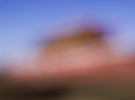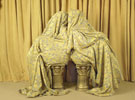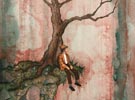Tang Keyang: Yeah.
Li Wei: I would like to know the audience’s opinions about my paintings, which are very inspiring and helpful.
Tang Keyang: We are not free to say anything while being tape-recorded.
Li Wei: I can barely follow you. But it is indeed helpful.
Tang Keyang: Your works are pertinent to our society, a society that has been transformed from being marked by handwork to being marked by a machine. In such a society, the trails left by workers have vanished. They have been replaced by standardization and digitalization.
There is an unprecedented possibility in the process. The possibility consists of multiple uncertainties that run parallel with each other. Some examples of the uncertainties are different filters, different transitioning mechanisms, different materials and different environments. The differences are interesting, random and entertaining. The differences themselves are art. You should use some kind of installations to bring the audience into the environment you predefined and they will observe your works from the angle you want them to be observer from. The installations may be similar to what photographers of the nineteenth and twentieth century invented for people to view their works.
Li Wei: Yeah, I have thought about that too.
Tang Keyang: The installations do not have to be independent equipment. They can be the invisible environment, the light, the building and hints about how to approach your works. All these can be installations. You should just put your existing works in context, instead of creating new works.
Li Wei: You bring a new meaning to the word installation. That is cool.
Tang Keyang: You may want to know some artists, whose works you can learn much from.
One of them is Gerhard Richter, who is an artist like no other. He has discovered many possibilities of translation before the advent of computer age. He has invented some very special techniques and is a living encyclopedia.
Another is Belgian artist Jan Fabre, who simulates the theatre environment before executing his works. He creates not only the works, but also a story to perform. The creating process is very interesting.
Li Wei: He creates an environment first.
Tang Keyang: He creates a possibility of performing first, and then transforms the painting process into a story, a story about what and how to paint. He once drew inside a box with blue ball pen. He carefully chose the lines to use and it was an accumulation of time and process. He spent a lot of time on it and created the object and the environment he had desired with energy and perseverance.
Daniel Libeskind, a well-known architect, uses his imaginative blue print to make stories too. He puts the objects composed of abstract lines back to the abstract space. In doing so, he aspires to establish a new order of the world, which cannot be explained by logic and reason. But it allows him to describe the relationships in the complicated world.
Li Wei: He has his unique understanding of the world.
Tang Keyang: The world is not a Cartesian space. It is not a world that can be explained by perspective. In this world, there are too many possibilities of refracting, overlapping, intersecting and penetrating. From renaissance to the emergence of divisionism, painters have been leveraging the same set of rationales. Some try to have their paintings approach the original in their mind. Some try to conjure up the spirit of their paintings. The spirit is not simply made up of the components of the objects. It also has to do with their techniques and ideals. It is the essence of painting.
Li Wei: You are right.










